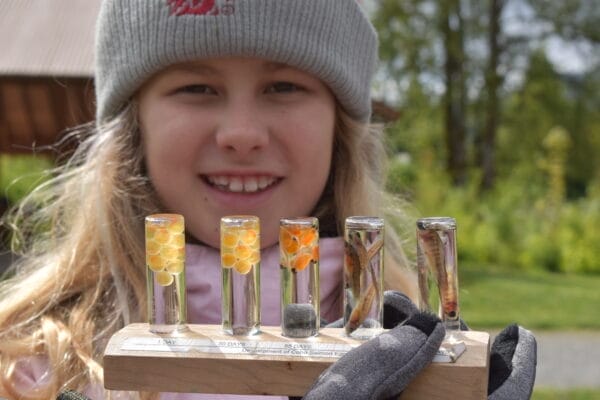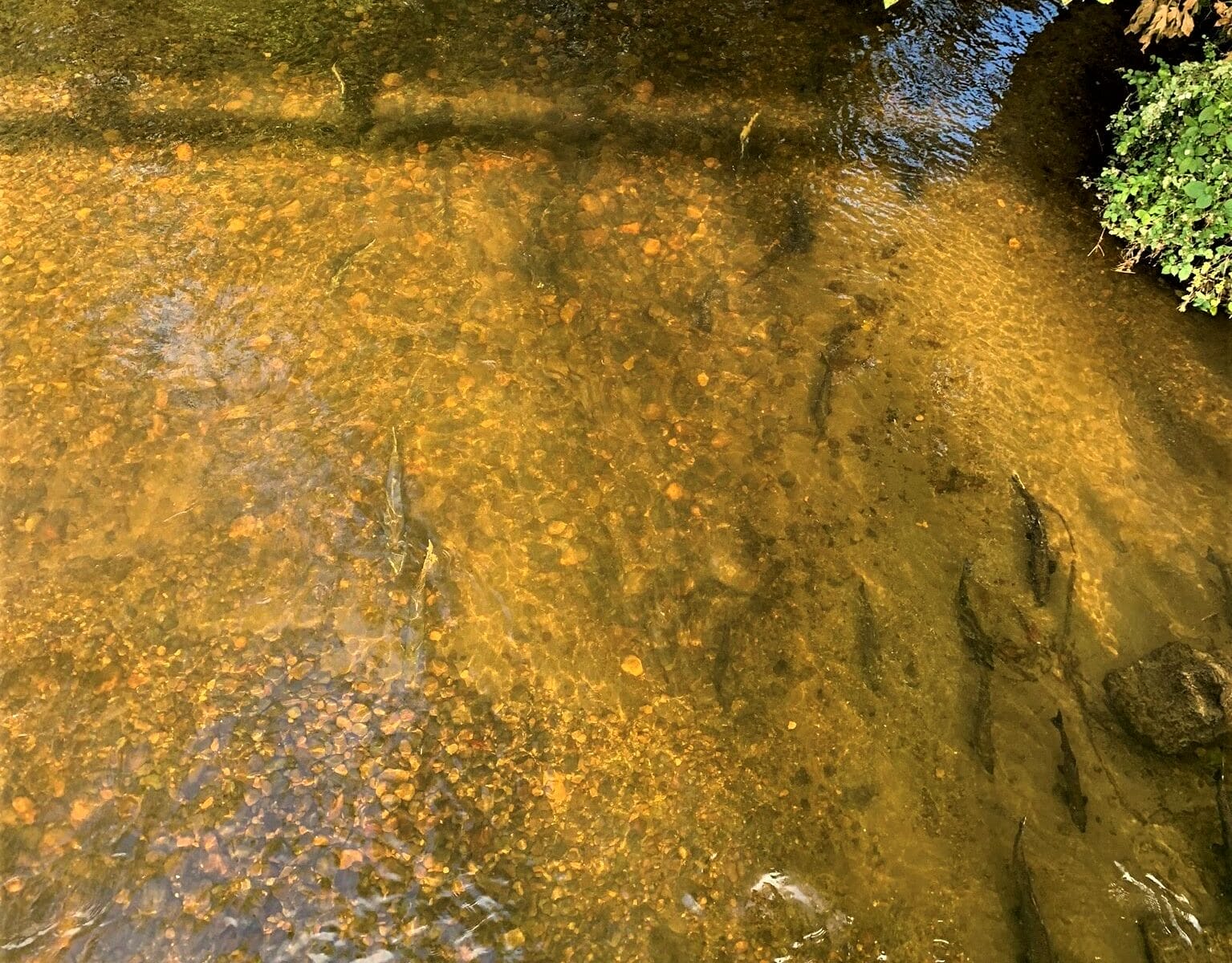How Our Restoration Work Is Helping Salmon
Salmon embark on incredible journeys, navigating treacherous waters and surmounting immense obstacles to return to their birthplaces and reproduce. For millennia, salmon have shaped their landscapes, nourishing countless species, including the orca. Unfortunately, modern challenges such as overfishing, habitat degradation, pollution, and the construction of dams have taken a toll on salmon populations, setting off a chain reaction that affects entire ecosystems.
But why are salmon so crucial to the survival of orcas? Imagine the journey of a salmon making its way home to spawning waters through smell alone. A salmon’s sense of smell is 1,000 times more sensitive than a dog’s, and a dog’s nose is 1,000 times more sensitive than yours! This means that salmon are one million times better at smelling than you or I. What’s more impressive is that salmon don’t return home for four to six years. Imagine smelling your way home after five years away . . . do you think you could do it?
Now imagine that in addition to following the scent of home, you also have to dodge predators 300 times larger than you (our resident southern orcas), and your whole neighborhood has been remodeled while you were away. That is just a touch of what our local salmon contend with on their way back to spawn.
Adult Southern Resident orcas need to find and eat 385 pounds of salmon each day. And, since they’re eating such a large volume, they try to only go for the largest fish which happens to be a threatened or endangered species. In a 2021 paper, researchers found that Chinook salmon are an important food source year-round.
Over the past few decades, the amount of large adult Chinook salmon has become harder to find. Historic photos such as the legendary June Hogs of the Columbia reveal salmon catches the size of people (a single Chinook weighing in at 85 pounds), but salmon weight has decreased in past decades. According to the Seattle Times, the average size of 4-year-old Chinook shrunk by 20 percent between 1975 and 2009 across the Northeast Pacific Ocean. This means orca need to do more fishing to make up for the lack of biomass while hunting for a dwindled Chinook population that has dropped to just 10% of historic numbers. Because salmon are smaller and less plentiful, orcas must work harder to survive.

Another threat salmon face is changing waterways. Indigenous people traveled on and fished northwest rivers since time immemorial, and naturally-flowing streams meandered across valley bottoms. Our salmon evolved in these slow-moving, dynamic systems, which tend to have cooler water, deeper pools, and areas where salmon can pull over and rest on their way upstream. When European and other settlers moved into this region, ecological randomness made it hard to build homes and cultivate crops, so they began managing rivers and lakes to make them more predictable, which changed the fluvial geomorphology (the science of how water moves through channels and shapes the earth). Settlers channelized the streams and drained floodplains, forcing water to flow efficiently out to sea. They also removed trees and logs that would have naturally fallen into waterways and created critical salmon habitats. Removing trees on the banks was followed by introducing non-native plant species, which degraded the ecological health of creekside habitats. The early settlers likely did not know how dramatically these changes would affect local salmon populations, which once were so plentiful. Now that we know the impacts, the Greenway Trust and many other organizations are working together to help support our dwindling salmon.
So, how exactly can we help salmon? Since most of the salmon’s life is out at sea, it is hard for us to help. However, we can influence the habitat quality in local creeks to support salmon’s early and late life stages. For almost 20 years, the Greenway Trust has worked to restore the riparian buffer—the ribbon of land that runs alongside creeks and streams—of Issaquah Creek and other salmon bearing streams. Issaquah Creek starts with headwaters and tributaries in the Issaquah Alps flowing 13 miles to empty into Lake Sammamish. The creek is host to Chinook, coho, and sockeye salmon, and has been identified as a critical spawning ground for salmonoid species. The Greenway Trust’s work focuses on replacing invasive species like Himalayan blackberry, English ivy, and Bohemian knotweed with native coniferous plants like Douglas fir and Western red cedar. These reintroductions bring with them a myriad of ecological benefits.

One benefit is providing food to baby salmon. Native plants on shore are the favorite home to native insects, and as branches reach over a stream, some insects will fall into the water and become food for juvenile salmon on their way out to sea. Those same branches that drop insects also provide shade in the summer months. This shade helps keep the water cool, a critical habitat requirement for salmon species because cooler water holds more oxygen, making it easier for these fish to breathe. By planting evergreen trees streamside, rainfall is intercepted by needles and branches slowing its descent to the ground. This interception reduces runoff and allows for more water to slowly enter the ground instead of rushing across the surface and into streams. That type of runoff can carry pollutants and debris into waterways, reducing clarity and choking native salmon as they make their way home to spawn. Finally, as trees age and grow, they topple over, slowly re-adding fallen materials into the creek and re-establishing the pooling and meandering it once had.
Starting in 2024, in addition to maintaining and expanding our work along the riparian buffer, the Greenway Trust is planning to start a project that will shape how the water flows in the creek by installing large woody material in the last mile of Issaquah Creek that winds through Lake Sammamish State Park. Large woody material replicates the impacts of large trees falling into the water. Still, their strategic placement helps guide the water flow through channels and directs how the water interacts with the stream bed and the surrounding banks. Our project intends to place over three hundred trees in the creek system to restart the natural processes that stopped over a century ago. This project is much more complicated than our traditional riparian planting efforts, but the impact and habitat improvement will be proportionally great. This project is only possible because of our partnership with the Northwest Hydraulics Consultants, The Watershed Company, the Washington State Department of Natural Resources, and Lake Sammamish State Park.
Projects like these and others undertaken by many partner organizations are just one way of supporting local salmon populations. So this year, if you make it to local salmon-bearing streams, take a second to check out the riparian environment and appreciate how interconnected our ecosystems are.
Want to learn more about salmon? Check out our virtual education program Forests and Fins; it’s all about salmon!





